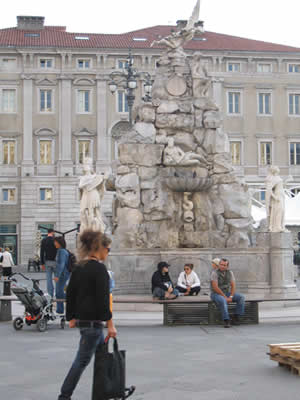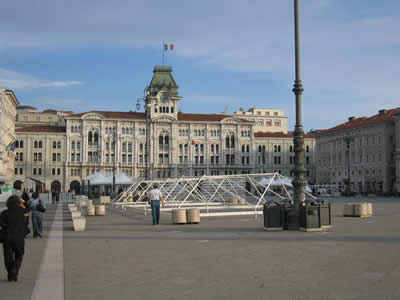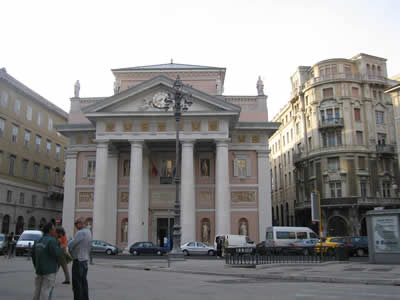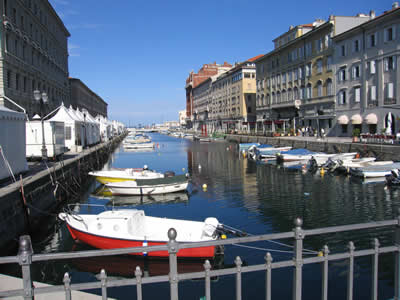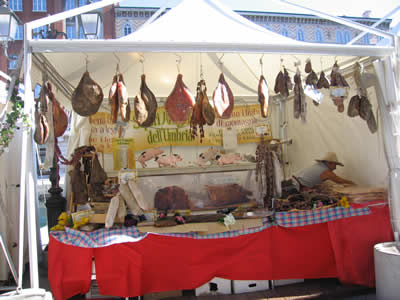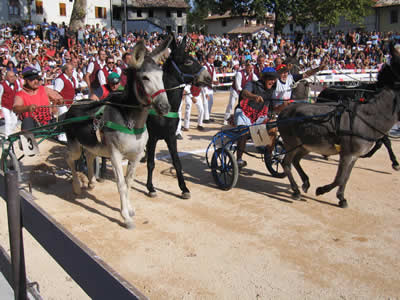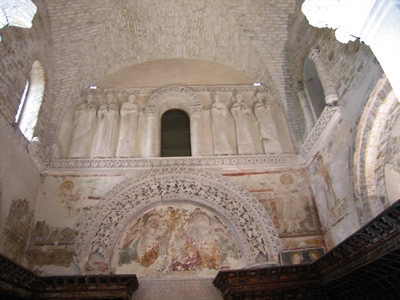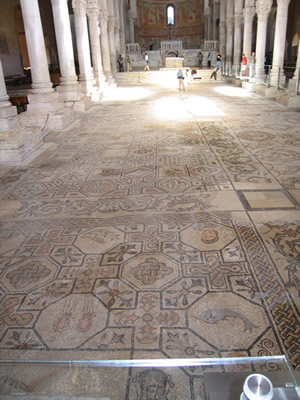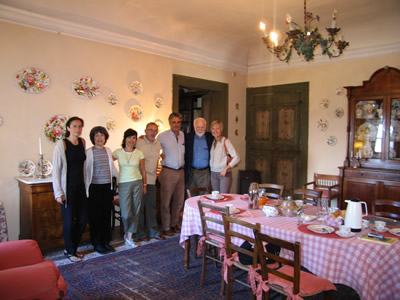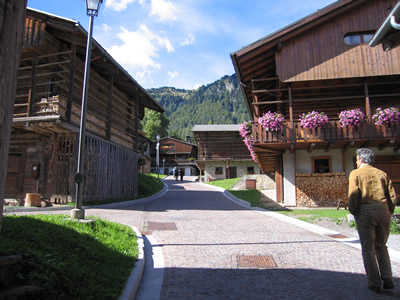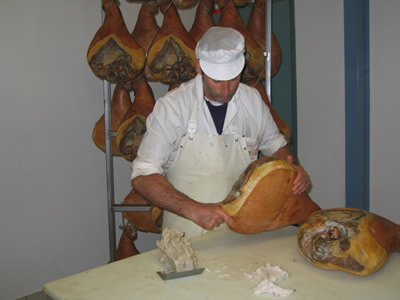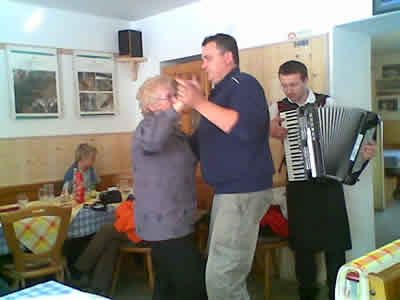 |
|
|
|
|
|
|
|
|
|
|
|
|
|
|
|
|
|
|
|
|
|
|
|
|
|
|
 |
 |
|
|
|
|
|
|
|
|
|
|
|
|

|
Fruili Venezia Guilia, Italy "Little Compendium of the Universe" — Ippolito Nievo
In May, June, and July 1946 at the close of World War II Ed Fancher, a soldier who fought with the 10th mountain division (the ski troops) in Italy in the Appenines and the Alps, was deployed to the northeastern corner of the country. The assignment: to block the Yugoslavian leader Marshall Tito from moving into Fruili Venezia Guilia, a province the commander insisted belonged to his own land. The mission succeeded and Ed went home. He never forgot the area’s riveting beauty and sometimes spoke of it when reminiscing about his army days. Ed and I, his wife, returned to Italy often, but never to F-V-G. A few of the trips were division reunions arranged to go back to the battle fields and meet the locals who always recalled with fervor the heroism of the troops who saved them from fascism. In the fall of 2006 at a seminar in New York hosted by the Italian Tourist Board we met Mr. Joseph Ejarque, general manager of Agenzia Tourismo, Fruili Venezia Giulia, who invited us to visit Italy’s least touristy and lesser known and traveled province. Three seasons passed and although the wheels were in motion for the trip we did little to prepare. It had been a busy year and for awhile we felt as though driving to the Jersey shore to sit on the sand was about all we could manage. Nevertheless, the week before our scheduled September 1 arrival we went to Barnes & Noble book store and looked through about two dozen travel guides. With the exception "The Lonely Planet" there was barely a mention of our destination. Oh dear, what had we gotten ourselves into? However, would we, who try to schedule ourselves tightly when we vacation, pass the time? We needn’t have given it a thought. In the next few days, we found two major surprises in our email. Firstly, our itinerary arrived and it was a compendium of wonderful excursions, chockfull of the kinds of places that we love to visit. The more we saw, the more we realized how many additional sights there were to see.
The second surprise was a communication from Count Luigi Deciani, proprietor of Villa Gallici Deciani, who asked us to verify that Ed had been in the region during the war. We had noted on our schedule that we would be sleeping at the villa and attending an English speaking dinner, but little did we know it would be one of the highlights of our time in Italy. Luigi asked Ed to bring documents of his tour of duty nearby. The illustrated book, "Mission Udine: The 10th Mountain Division at the Yugoslav Border," got passed around a lot as people we met borrowed it and hastily took it to the photocopiers. Our sojourn began in Trieste, traditionally a capital of mixed ethnicity with an international feel and a long history of domination by several powers. Remnants of imperial grandeur remain. Tucked into the northeast corner of Italy, it is but five miles from Slovenia, 10 from Croatia, and a few hours drive from Austria. It had been a bustling Adriatic harbor, a maritime gateway through which goods flowed in and out of the Austro-Hungarian Empire. It remains Italy’s main seaport. A ramble around the center is a confrontation with Trieste’s many pasts. The heart is Piazza dell' Unita d’Italia, the main square facing the Adriatic. The Lower Town, laid out in the 18th century by Austrian empress Maria Theresia, is a precisely planned checkerboard dotted with imposing churches, public buildings, and the opera house, a scaled down version of Milan’s La Scala. The Austrian influence has a lengthy pedigree in Trieste’s coffee culture. The city and the bean go back to the 18th century. There are so many coffee houses that Trieste has been dubbed "Vienna by the Sea." James Joyce had his own name for Trieste, Europiccola, a little Europe. James Joyce, you wonder? His native Dublin described and peopled so vividly in his books "Ulysses" and "Dubliners" were partially written in exile when Joyce lived here (1904-1915). At the time Trieste belonged to the Austro-Hungarian Empire. Although many residents spoke an Italian dialect, German was the official language. The writer delighted in the town’s polyglot and cosmopolitan character. Austrians, Italians, Slavs, Hungarians, Greeks, and Jews mingled in the streets and cafes. You can bump into Joyce (well, sort of) as you cross the Canal Grande. A life-sized and very natural looking statue portrays the author with a slouch hat walking home and carrying a book. The Joyce Museum occupies a room in the public library and the Tourist Office distributes a Joyce itinerary listing 45 sites associated with the literary lion.
From our superb accommodations at the five-star Hotel Grief Maria Theresia in Barcola, overlooking the Gulf of Trieste and a five-minute ride to the city proper, we rushed to visit the Square of Italian Unity in both daylight and in darkness. The focal point of what the Triestini call Borgo Teresiano or Teresa’s Town is this magnificent central square, the city’s al fresco living room. One of the largest in all Italy, it is a vast space opening to the sea on one side. It was here at a sidewalk table of the famed Caffe Degli Specchi, the best restaurant in the piazza, that we sampled our first sips of exquisite white Fruilian wines and watched the dusk go down while the lights went up and illuminated the beautiful four-story carved limestone buildings. We moved inside to the handsome mahogany dining room for the evening meal. Our brief pre-trip research had tipped us off that we should expect the very highest quality products. Even the renowned New York chef-restaurateur Mario Batali travels to the region to eat and had said that the food is "a delicious blend of familiar Italian food and exotic to my mind Austro-Hungarian and Slavic flavors." The menu deftly straddled the haunting tastes that would follow us through every bite we took during our stay—grilled fresh fish, expertly cooked seafood, vegetables blessed by the sun, and seductively delectable pastas. On the next days we and our guide explored Trieste and its surroundings and hit some of the highlights. The atmospheric old quarter, Citta Vecchia, a neighborhood of narrow climbing streets cluttered with bookstores and antique shops is capped by the medieval cathedral of San Giusto, a similarly named castle, and the remains of a Roman forum and basilica.
Perhaps the most visited attraction in Trieste is Miramar Castle perched at the edge of a cliff and providing a glorious sighting of the bay. You can listen to an English language audio about Hapsburg history as you stroll the rooms decorated to the taste of the resident Archduke Ferdinand Maxmilian. During his reign as Emperor of Mexico Maximilian was executed in a rebellion. You can also walk the English- and Italian-style gardens found in the property’s lovely parklands. Grotta Gigante, a 100-year old tourist destination, is another popular mecca. Fabio Forti, a life-long researcher, restorer of caves, and overseer of the operation, delayed his holiday to greet Ed and escort him down the 500 interior steps. The men reminisced about the role of the Alpini during the war. Forti said the locals were surprised to find that there were American mountaineers, not just the more familiar ones from Austria and Italy. The cave, the tallest in the world, has palm tree-shaped stalagmites, which have been burnished brilliant rust by drops of water pounding them. Following our stay in Trieste, we were off to the races, the Fagnana donkey races, that is. Held yearly on the first Sunday in September, it began as a marketplace and has been going since 1891. God is clearly on the side of the donkeys as it has never rained during its 117-year history. Five men and women drive the sulkies (carts) and vie in five competitions. The animal that pulls ahead at the start is often the one who reaches the finish line first. Finalists compete in the grand round to choose a winner. Though not as serious a contest as the Palio in Sienna, bands, banners, and a cheering section in a temporary stadium added to the excitement and color. Handicrafts and food were sold at stalls in the main square. That night we slept in Udine, a town exploding with culture despite its limited population of fewer than 100,000. Sunday is usually a quiet day and all the high-end shops, of which there are many, were closed. However, Matteotti Square teemed with action for on this day the monthly flea market was operating. During the week antique dealers are replaced by clothing and vegetable vendors. From our table at Café San Giacomo we had a front row seat of the activity.
What amazes about Udine is the quality of the art and architecture. The center is not a section to hurry through as it possesses many well-preserved ancient monuments. The Piazza Liberta reminds one of the magnificent squares in Venice. Equally imposing are the squares San Giacomo (Matteotti) and Duomo, location of the cathedral. The mark of Raphael’s pupil, Giovanni Da Udine can be found all over the district. He designed the Clock Tower and the San Giacomo Fountain. The city’s best views are from the hill upon which the castello stands and the most valuable treasures are exhibited in the Patriarchal Palace, now a museum. Inside is a masterful collection of the work of Giambattista Tiepolo. Summoned by the Patriarch from his Venetian birthplace in 1726, his output of mostly religiously themed frescoes covering the walls and ceilings of the palace was prolific. A commanding staircase reaching three stories high beckons you to climb up to get a better look at the mural on the top floor ceiling. If you take the time to linger in the red, blue, gold and other chambers you will gain a profound appreciation of the painter’s mastery of his craft from his use of color to the movement and details in his art. Our next stop was Cividale del Fruili established in the first century before Christ by Caesar whose statue stands in the square. The Lombards arrived here from Hungary and the Archeological Museum holds memorabilia from their times. Stone and stucco houses, looking very much of the Middle Ages, line the skinny winding alleys. Vine-covered hills run up to the Alps and the village, which is filled with wine bars, is one of the stops, along with neighboring Gorizia, on the Strada del Vino (Wine Road).
The most interesting structures in the town, which was the capital of Lombard Fruili until 568, are the Palazzo dei Provveditori Veneti, housing the National Art Museum; a medieval Town Hall; a 15th-and 16th-century Duomo; Devil’s Bridge, which crosses the Latisonna River; and an 8th-century flawless gem, Lombard/Byzantine/ RomanesqueTempietto or Little Temple with enchanting painted stucco decorations depicting female figures. Step out onto the catwalk fronting the Little Temple and you can see mountains, a river, and Slovenia. The land between Cividale and the small frontier city of Gorizia reminds one of California’s Napa Valley where many vineyards sit side by side. The historical center of Gorizia, near the Slovenian border at the foot of the Julian Alps, is the castle on the hill. From here you can glimpse Nova Gorica, now part of Slovenia. High on the list of must-sees is Musei Provinciali on the grounds of the castello where silk and embroidery from the days of Maria Theresia are exhibited. The Museum of Fashion also displays the collections of modern Italian designers. Capucci and Missoni were featured not long ago. Janice Sussman, a poet who traveled with the high-end Butterfield & Robinson Tours, said that she felt the two days she spent in this locale touring the ghetto, the synagogue, and its museum were exceptionally fulfilling. On the morning we spent in Grado, the sunny island or Isolde del sole, our attention veered briefly from history and turned to R & R. During the May to October season, vacationers sun themselves on the sand, sail on the lagoon, take spa treatments at the Centro Bennesserre, amble along the waterfront on the kilometer-long marble promenade, La Diga, and enjoy the amenities of the pastel-colored 19th-century hotels on Viale Dante, the main boulevard and a pedestrian zone. Soon we were back to learning more about the country’s archaic past. In Italy you can never get far away from it. Even in Grado we came upon a 500 A.D. basilica built over a Roman church with well maintained mosaic floors in the city’s center. Nearby are the ruins of the ancient Roman city of Aquileia. Its archeological area and Patriarchal Basilica with a lofty bell tower are designated by UNESCO as a World Heritage Site. English language audio tapes guide you through the remarkably intact excavation of this port city. The Corinthian columns of the Roman Forum are well preserved as are some of the mosaics. Also uncovered and brought to light during digs were foundations of houses, a mausoleum, the Sacred Road, and a dock.
If it’s Tuesday it must be the evening of an English-speaking dinner hosted weekly by Count Luigi Deciani at Villa Deciani in the village called Montegnacco in a town of Celtic origin, Cassacco, which is north of Udine. Ensconced in the magnificent landscape of a sprawling estate with gentle hills on the south side and a grand view of the Alps from the north, the property and title have been in the family for generations. During the 18th century the villa was decorated with stuccos and frescoes in delicate pastels and furnished in grand style with eye-stopping antiques and artifacts. Renovated to its former stateliness, it was a privilege to sleep in one of the elegant suites upstairs. Guests dine at a long communal table in the adjoining stone-walled lodge. Often entertainment or a theme are part of the evening, which always includes great food, fine wine, scintillating conversation and a cosmopolitan group of guests. On the night we were present others came from Sweden, Poland, United Kingdom, Austria, and Australia. Here’s a link to the Tuesday night blog, which is updated weekly. http://www.esdnews.blogspot.com/ Food had played an important role in our travels thus far and the momentum around it grew as we continued on our trail and visited the production sources of some of those famous products. In Sauris we were offered a private tour of Proscuittificio Wolf. We wandered the factory and watched the process of air-curing pork legs to turn them into world-famous speck and proscuitto di Sauris. From nearby Forni di Sopra, we drove to the crest of the mountain to observe independent cheese producer Ivan Marocutti convert milk into ricotta and smoked ricotta and to get acquainted with his herd of goats grazing in a pasture whose air under an almost cloudless sky was pure and perfumed with the scent of evergreen trees.
Forni di Sopra is an all-season vacation spot. In late summer we came upon many older hikers who were staying at the 15 hotels. The picturesque settlement in the valley affords a view that vies with or possibly surpasses the one in the American Rockies. The village is set on a hill. Its homes are made from stone and white stucco with flower-laden wooden balconies. Red seems to be the preferred color for the blossoms. An archivist led us from the old town square to two important churches. San Floriano, dating from the 13th century, has walls embellished with 15th century frescoes. Santa Maria Asunta, the main duomo, is still in use today and is crowded with religious art and sculpture. The trip was drawing to a close. We had seen much, but it was minuscule against the backdrop of all that the region offers. Our remaining nights were spent in Tolmezzo and Tarvisio. Tolmezzo’s stellar attraction "Il Museo Carnico delle Arti Populari" interprets all aspects of Carnic life from the 14th through the 19th centuries. Thirty rooms draw the visitor into the work and home environments of former times. The authentic reconstructions stir up a desire to step into the tableaus to cook over the kitchen hearth, hammer cooper and brass at a workshop, assist weavers and carpenters in their chores, or peek into a wedding chest to examine its contents. Tarvisio beckons tourists in summer and winter. Its tiny population of 5,000 swells with visitors who arrive to ski, hike, and to ride the tram to Monte Lussari, its most popular elevation. The destination also attracts pilgrims to the famous sanctuary of the Madonna Del Monte Lussari at the top of the slope. Situated on the Italian, Austrian, and Slovenian borders, citizens of all three countries revere the shrine as their own. Something about Fruili Venzia Guilia, a microcosm of all that’s wonderful in Italy, casts a spell. It may be the arresting landscape--expanses of field, the forest laid out against a spectacular panorama of green-brown and white-tipped mountains. It may be the timeless style of an enduring history or the sense of purpose of people whose roots are dug so deep that they cannot be unhinged by any adversity. Ippolito Nievo, a mid-19th century writer, called Fruili Venezia Guilia, a "little compendium of the universe." Hotels
Hotel Greif Maria Theresia, located in the suburb of Barcolo and the fanciest lodging in Trieste, is a five-minute bus ride or a pleasant 20-minute ferry trip from the city. Housed in an old refurbished villa, the boutique albergo combines history and luxury. Considering the region’s ties to Austria, it is no surprise that the rooms are decorated with stunning Biedermeier furnishings. During our stay two Australians tied the knot in afternoon nuptials at the 36-room hotel. A lively party followed. As we sat in the lobby, it was fun to observe families with young children and guests from far away dancing and enjoying themselves. In keeping with what today’s traveler desires while on the road, there is a well-equipped gym, a sauna, and a capacious swimming pool where water aerobics classes take place for both adults and children. Even if you don’t bed down at the Marie Theresia, consider visiting its dining room where you will be entertained by live music. Reservations for the tables on the terrace with its mesmerizing view of the bay are a must. You won’t be traveling there just for the seascape. Food and wine are superb. Hotel Greif Maria Theresia Viale Miramore 109, 34136 Trieste, Tel. 0431 42261. email: griefts@tin.it The flags of the country and province hanging above the entrance of Astoria Hotel Italia Udine waved hello and the colorful window boxes filled with bright red bougainvillea bid a warm welcome. The white stone walls, cornflower blue shutters, and the carved arches over the windows make for a very inviting exterior. Although only rated four-star, it turned out to be a find. More than a century old with an ambiance that exudes refinement, it matches the style of the historic district in which it is located. A recent sprucing up has created comfortable, nicely furnished rooms with modern day amenities. Included in the price is a breakfast buffet with the choicest breads, pastries and other goodies.
Astoria Hotel Italia Udine, Piazza XX Settembre, 24, 33100 Udine. Tel. 0039 0432 505091. email: Astoria@xnet.it Of all the hotels in which we stayed none was as proud of its heritage as the Grand Hotel Entourage in Gorizia. The hotel manager, Antone, eagerly showed us around and related how Charles X, King of France and the last of the Bourbons, and his family arrived in 1836 to take up residence at Palazzo Stressoldo, dating from 1446. Our room, one of 40, was cheerful, although not lavish. The staff was exceptionally helpful. Unfortunately, the restaurant, which has a fine reputation, was closed because it was Monday evening. Grand Hotel Entourage, Palazzo Strassoldo, Piazza S. Antonio, 2, 34170, Gorizia. Tel. 0481 550235. email: info@grandhotelentourage.it. http://www.entouragegorizia.com Villa Gallici Deciani, Way Gaulish, 2733010 Cassacco, Udine, Italy. Our last night was spent at Hotel Valbruna Inn, Valbruna, near Tarvisio. It could not have been a better selection as the surroundings seemed to synthesize all that is grand about the mountainous region of Venezia Fruili Guilia. The Inn is a cooperative enterprise of 12 local friends. One of them lives in Aspen with his American wife and family, but maintains strong ties to the co-op. The website http://valbrunainn.com communicates in words and pictures the love of and pride in the venture. We can only add, "Be sure to explore some of the many nearby tunnels." Hotel Valbrunna Inn, Via Giulie, 2. 33010 Malborghetto, Valbrunna. Tel. 39 0428 660554. Email; info@valbrunnainn.com Restaurants Caffe degli Specchi, Piazza Unita d’Italia 7, 34100 Trieste. Tel. 39 040 365777. email info@caffespecchi.it, http://caffespecchi.it (see article for details)
Café Tommaseo is a Trieste favorite located right in the heart of town. The city’s oldest coffee house dating from 1830, it has turned into a full-service restaurant serving delicious eats. Any of the primi piatti pastas would make a substantial and superb lunch. Named after the patriot Nicola Tommaseo, several display cases hold memorabilia relating to his life and times. With its turn of the century lighting, old-fashioned cash register, and beautifully proportioned rooms divided by graceful arches decorated with pink-painted stucco cherubs and blossoms, you might be sipping your espresso in Vienna. The terrace facing the water is shielded from the sidewalk traffic by juniper and oleander hedges and from the sun by oversized umbrellas. Caffe Tommaseo, Piazza Tommaseo 4/c, Trieste. Tel. 040 362666. http://www.caffetommaseo.com A stop Restaurant Principe de Metternich combines well with a tour of Miramar Castle. Aligned along the same coast, the restaurant overlooks a marina. And of course, in summer, the only place to sit is outside. Plump and meaty mussels come straight to the kitchen from the sea. The chef prepared a very creditable mushroom pasta. It was here that we learned about café chacerato, the Italian version of iced coffee, which we continued to order throughout our stay. Espresso and ice are shaken together and form a layer of foam on top of the drink. The effect is much like a chilled cappuccino. Ristorante Principe di Metternich, Riva Massimilliano e Carlotta 2, 34136 Grignano, Tel. 040224189. In Cividable del Friuli we went to lunch at a totally charming and rustic restaurant, Al Tre Re. The food was completely creative, yet utterly of the region, like what is prepared by a nonna. Italy’s mother starch, pasta, was uniquely filtered through a prism of all that is fresh and famous in the region. The menu meshed perfectly with the country-like surroundings, small dining rooms paneled in stone or wood, and a big hearth. We first tasted the outstandingly delicious Fruilian pastry, Gubana, at Al Tre Re. Prepared with a yeast dough and stuffed with hazel and pine nuts, sultanas, and macaroons marinated in rum and wine, it is beloved by inhabitants of the Natisone Valley, which stretches from Cividale to Slovenia. The recipe originated in neighboring Gorizia and over the border of Slovenia, but Cividale is its true home. Al Tre Re Ristorante, Via Stretta San Valentino, 31, Cividale del Fruili, Udine, Tel. 0432 700416. email:trere@libero.it At Da Ovidio, an old-fashioned restaurant in Grado, the owner fusses over each customer, language differences not withstanding. The surroundings are simple and cozy. A large glass dispenser on a table near the door measures out portions of grappa, the clear grape-based pomace brandy offered as a digestivo or after-dinner drink. The seacoast and islands of which Grado is a part are collectively known as Graisana. Famous for its fresh fish chowder, boreto alla graisana is prepared with rumble, olive oil, vinegar and garlic. Polenta, another popular preparation serves as a side to the soup. Da Ovidio, Via Marina, 36, Grado. Tel. 0431-80440. email: info@ristorantedoovidio.com, http://ristorantedaovidio.com.
A delightful place to lunch when visiting Saris to shop at Wolf is the Alpine-type seven-room chalet, Meuble Schneider, named for the Pietro Schneider, the German butcher who started curing proscuitto in 1862 and whose store morphed into the Petris family-run business, Wolf. An 1804 structure stood on this site, but was damaged by fire and reconstructed. The inn’s dining room, Ristorante Alla Pace (To the Peace) is managed by a nonna, Signora Franca, who cooks lively Saurano-style dishes. The Germanic influences in the building are easily recognizable. Regional fare, such as tagliolini with speck, pasta e fagioli, gnocchetti, a local style goulash, and venison with polenta appear on the menu. A commanding fireplace is the focal point of the main room. In the small cantina/enoteca you can enjoy Fruilian wines and the locally brewed Zahre beer. Ristorante Alla Pace, Meuble Schneider, Sauris de Sotto, A 1212M. SLM. Tel. 0433 86010. email: Futurasauris@libero.it. The repertoire of Fruilian tastes expanded with every restaurant we visited. At Vecchia Osteria Cimenti in Villa Santini we were served a menu designated by chef/owner Paolo Cimenti as summer foods, dishes composed of herbs, cheeses, and a variety of mushrooms. Course after course came to the table—cheese soufflé made from fresh, as opposed to the usual aged, cheese and truffles and accompanied by zucchini flowers stuffed with ricotta; three types of ravioli, each filled with a different herb; and lasagna with exotic fungi and cheese. Patrons from all over the area dine in these rustic rooms whose walls are hung with art and whose up-beat dining room has a large hearth in keeping with the habit of the region. Vecchia Osteria Cimenti, Via Cesare Battisti, 1, 33029 Villa Santina. Tel. 0433-750491. email:vecchiaosteria@libero.it All small mountain inns seem to have dining facilities attached to them. At Albergo Nuoitas the aptly named Polenta e Frico pays homage to two of the best loved dishes of Carnia. Frico is made from grated aged Montasio cheese mixed with cornmeal and fried like a large flat wafer until crisp. Some recipes, or what the Italians translate as prescriptions, include chopped onions or potatoes. Different versions are prepared with various seasoned cheeses and eggs. The appropriate pairing is creamy polenta. Other house specialties are minestrone cooked in the kitchen’s own style, Swiss fondue—a warming after-ski delight—venison, and potato gnocchi. The house’s own dolce include strudel and apple crostata. Prices are reasonable, food is great, and the ambiance is just right for a mountainside setting. Polenta e Frisco, Albergo Nuoitas, 33024 Forni Di Sopra. Tel. 0433 8836. email: polentaefrico@libero.it
While searching for a place to eat dinner on the quiet darkened streets of ancient Tolmezzo, we spotted Posta, an osteria, or simple Italian restaurant serving wine by the glass and regional food. A café and gelateria is on the street level and the main dining room is upstairs. It was full, but we later found out that the reason wasn't because there was no place else to eat. We learned from American expatriates, who approached us to help with the menu translations, that diners had come from miles around drawn not just by the modest prices, but by the superb renditions of "cucina tipica Carnica." We sampled a new interpretation of frico, the fried wafer made from local Montasio cheese and uniquely shaped like a bowl to hold spinach, bacon, and gnocchi. Another typical preparation, cjarsons (ravioli), was served three ways: sprinkled with smoked ricotta and stuffed with pignoli; with spices; and with nuts and cinnamon. Cornmeal biscuits complemented a zabaglione dessert. Clearly here was a restaurant whose popularity came from softly whispered words of mouth. Posta, Via Roma 4, Tolmezzo. Tel.0433 40801. email: pizzpostatolmezzo@tiscali.it Three restaurants are aligned on the top of the mountain at Monte Lussari. We chose to lunch at Rifugio Locando al Convento because our hosts whose recreation centers around the mountain were well acquainted with the owner. He played Slovenian tunes on his accordion to enliven a birthday party as the celebrants polkaed and waltzed to the music. Once more we enjoyed a meal made from superb Carnian products. Ravioli were stuffed with Montasio cheese and sprinkled with grated smoked ricotta. Ricotta and arugula were used in the preparation of gnocchi. And for the last time we savored a delicious slab of frico and its sidekick, polenta. Help, someone send me the recipes! Rifugio Locanda al Convento, Monte Lussari. Tel. 39 0428 63184. Winter 2007-08 |
||||||||||||||||||||||||||||
